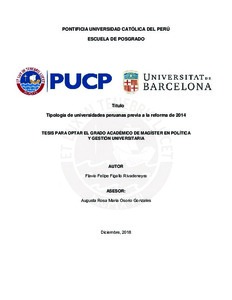| dc.contributor.advisor | Osorio Gonzales, Augusta Rosa María | |
| dc.contributor.author | Figallo Rivadeneyra, Flavio Felipe | es_ES |
| dc.date.accessioned | 2019-02-27T17:07:45Z | es_ES |
| dc.date.available | 2019-02-27T17:07:45Z | es_ES |
| dc.date.created | 2018 | es_ES |
| dc.date.issued | 2019-02-27 | es_ES |
| dc.identifier.uri | http://hdl.handle.net/20.500.12404/13560 | |
| dc.description.abstract | Este trabajo presenta una línea de base sobre la situación de las universidades peruanas
antes de la implementación de la ley universitaria de 2014 (N° 30220) que obliga a un nuevo
licenciamiento de todas ellas. La fuente ha sido el II Censo Nacional Universitario de 2010.
A partir de las características de acceso, enseñanza e investigación definimos cuatro tipos
de universidades. La conclusión principal es que tanto las universidades públicas como las
asociativas han sido el soporte de la ampliación de la matrícula incorporando una mayor
diversidad de estudiantes que las universidades societarias que se han concentrado en una
oferta de carreras profesionales de bajo coste, y con un desarrollo incipiente de la
investigación. Las universidades sin distinguir su condición jurídica son más selectivas y
homogéneas en su composición, solo un pequeño grupo de ellas por ubicación y necesidad
estaría expandiéndose hacia nuevos sectores sociales. | es_ES |
| dc.description.abstract | This paper presents a baseline on the situation of Peruvian universities before the
implementation of the university law of 2014 (No. 30220) that requires a new licensing of all of
them. The source was the II National University Census 2010. Four types of universities we
define based on the characteristics of access, teaching and research. The main conclusion is
that both public and associative universities have been support for the expansion of enrollment
by incorporating a greater graduation of students than for profit universities that have
concentrated on a low-cost career offer, and with an incipient development of the investigation.
The universities without distinguishing their legal status are more selective and homogeneous
in their composition, only a small group of them by location and need to expand into new social
sectors. | es_ES |
| dc.description.uri | Tesis | es_ES |
| dc.language.iso | spa | es_ES |
| dc.publisher | Pontificia Universidad Católica del Perú | es_ES |
| dc.rights | info:eu-repo/semantics/openAccess | es_ES |
| dc.rights.uri | http://creativecommons.org/licenses/by/2.5/pe/ | * |
| dc.subject | Educación superior--Perú | es_ES |
| dc.subject | Universidades--Legislación--Perú | es_ES |
| dc.subject | Reforma universitaria--Perú | es_ES |
| dc.title | Tipología de universidades peruanas previa a la reforma de 2014 | es_ES |
| dc.type | info:eu-repo/semantics/masterThesis | es_ES |
| thesis.degree.name | Maestro en Política y Gestión Universitaria | es_ES |
| thesis.degree.level | Maestría | es_ES |
| thesis.degree.grantor | Pontificia Universidad Católica del Perú. Escuela de Posgrado | es_ES |
| thesis.degree.discipline | Política y Gestión Universitaria | es_ES |
| renati.discipline | 191847 | es_ES |
| renati.level | https://purl.org/pe-repo/renati/level#maestro | es_ES |
| renati.type | http://purl.org/pe-repo/renati/type#tesis | es_ES |
| dc.publisher.country | PE | es_ES |
| dc.subject.ocde | https://purl.org/pe-repo/ocde/ford#5.03.01 | es_ES |






